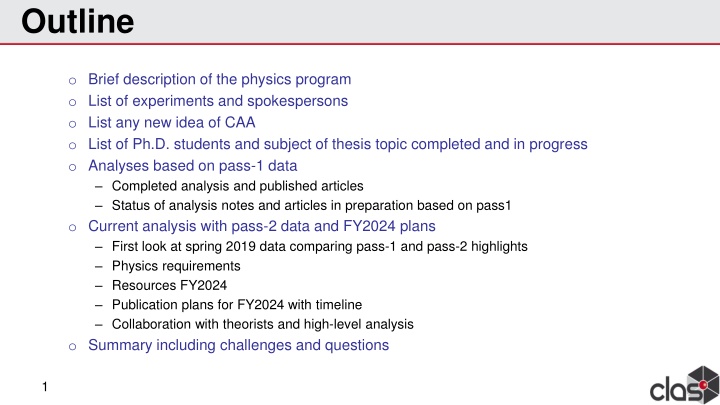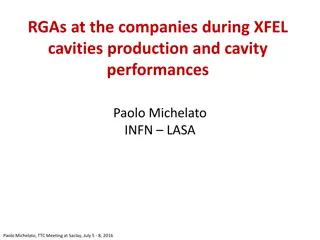
Deep Exclusive Science Program and Physics Analyses Overview
Explore the cutting-edge Deep Exclusive Science Program focusing on Generalized Parton Distributions and advanced proton imaging in the field of physics. Discover completed analyses, ongoing experiments, Ph.D. student theses, and future research plans.
Uploaded on | 3 Views
Download Presentation

Please find below an Image/Link to download the presentation.
The content on the website is provided AS IS for your information and personal use only. It may not be sold, licensed, or shared on other websites without obtaining consent from the author. If you encounter any issues during the download, it is possible that the publisher has removed the file from their server.
You are allowed to download the files provided on this website for personal or commercial use, subject to the condition that they are used lawfully. All files are the property of their respective owners.
The content on the website is provided AS IS for your information and personal use only. It may not be sold, licensed, or shared on other websites without obtaining consent from the author.
E N D
Presentation Transcript
Outline o Brief description of the physics program o List of experiments and spokespersons o List any new idea of CAA o List of Ph.D. students and subject of thesis topic completed and in progress o Analyses based on pass-1 data Completed analysis and published articles Status of analysis notes and articles in preparation based on pass1 o Current analysis with pass-2 data and FY2024 plans First look at spring 2019 data comparing pass-1 and pass-2 highlights Physics requirements Resources FY2024 Publication plans for FY2024 with timeline Collaboration with theorists and high-level analysis o Summary including challenges and questions 1
RGA Deep Exclusive Science Program Generalized Parton Distributions (GPDs), and 3 dimensions (3D) imaging of the proton, 2 in transverse coordinate space and 1 in longitudinal momentum space. Mechanical Structure of the Nucleon, a novel way to describe the nucleon structure, access to the pressure, strong force distribution and the mechanical radius of the proton The program requires the measurements with high precisions of deep exclusive processes, both BSA and cross sections.
Completed analyses and published articles based on pass1 data o G. Christiaens et al. (CLAS Collaboration) First CLAS12 Measurement of Deeply Virtual Compton Scattering Beam-Spin Asymmetries in the Extended Valence Region Phys. Rev. Lett. 130, 211902 Published 25 May 2023 o S. Diehl et al., "First Measurement of Hard Exclusive - ++Electroproduction Beam Spin Asymmetries off the Proton", Phys. Rev. Lett. 131, 021901 (2023). o S. Diehl et al., "A Multidimensional Study of the Structure Function Ratio LT / 0from Hard Exclusive +Electroproduction off Protons in the GPD Regime", Phys. Lett. B 839, 137761 (2023). o A. Kim et al. (CLAS Collaboration), "Beam Spin Asymmetry Measurements of Deeply Virtual 0Production with CLAS12", arXiv:2307.07874, submitted to Phys. Lett. B.
pass1/pass2 Comparison for Exclusive Channels Pass 2 provides significant improvements for exclusive reactions e p +( -) missing - e p e +X missing neutron Q > 1.0 GeV W > 2 GeV -t < 1.5 GeV all particles in the FD +in the CD! pass 2 pass 2 pass 1 pass 1 in addition, significant resolution improvement for particles in the CD signal gain: + 60 %
List of PhD students and subject of thesis topic completed and in progress o Brandon Clary (Ph.D. in 2020, no publication yet): Exclusive Production Beam Spin Asymmetry Measurements with CLAS12 (pass1 data) (Uconn) o G. Christiaens (Ph. D. in 2020) First CLAS12 measurement of DVCS beam-spin asymmetries in the extended valence region (pass1 data) (Saclay) o S. Lee (Ph. D. in 2021) DVCS cross sections (pass1 data) (MIT) o D. Bulumulla (Ph.D. in 2023) Deep Virtual Pion Pair Production (pass1 data) (ODU) o R. Johnston (Ph.D. in 2023) Deep Virtual exclusive pi0 cross section (pass1 data) (MIT) o P. Moran (Ph.D. Expected in 2024): Deep Exclusive Phi cross section (pass1 data) (MIT) o Nicholas Trotta (Ph.D. Expected in 2024): Beam Spin Asymmetries and Spin Density Matrix Elements from Deeply Exclusive rho^0 production (pass1 data and pass2 data in progress) (UConn) o Ricardo Santos (Ph.D. Expected in 2025): Differential Cross Sections of Deeply Virtual \pi+ production (pass2 data) (Uconn) o Gursimran Kaines (Ph.D. Expected in 2026): Beam Spin Asymmetries of Deeply Virtual omega production (pass2 data) (Uconn)
PAC Proposal, CLAS Approved Analysis (CAA), and Analyses based on pass2 data in FY24 oStefan Diehl and Kyungseon Joo, The Studies of the N->N* Transition GPDs with CLAS12, to be submitted to PAC 52 in 2024. oStefan Diehl and Kyungseon Joo, Beam spin asymmetry measurements of deeply virtual exclusive pi+ production in the backward angle with CLAS12. oUtsav Shrestha, Beam Spin Asymmetries from deeply virtual exclusive ep->K Lambda(1520).
Summary and Next step o Excellent progress based on pass1 data processing (Common analysis note) o Excellent team in place for the deep meson exclusive processes from University of Connecticut o How to proceed with DVCS cross section current analysis note towards publication this year? o No dedicated manpower for DVCS analysis from Pass2 o Recruiting additional manpower and involving other institutions to enhance our research capabilities. o Develop common tools & procedures for understanding the detector efficiency for each configuration. o Better coordination with other run groups, especially with RGB and RGK teams, to exchange insights and data analysis techniques. o Collaborate with theoretical physicists and phenomenologists to refine the extraction of physics observables in the current stage of our analysis.
Summary and Next step o Excellent progress based on pass1 data processing (Common analysis note) o Excellent team in place for the deep meson exclusive processes from University of Connecticut o How to proceed with DVCS cross section current analysis note towards publication this year? o No dedicated manpower for DVCS analysis from Pass2 o Recruiting additional manpower and involving other institutions to enhance our research capabilities. o Develop common tools & procedures for understanding the detector efficiency for each configuration. o Better coordination with other run groups, especially with RGB and RGK teams, to exchange insights and data analysis techniques. o Collaborate with theoretical physicists and phenomenologists to refine the extraction of physics observables in the current stage of our analysis.
DVCS Cross Section Measurement Analysis-note under review DVCS Cross sections Impacts New inputs for global fitting Unprecedentedly wide phase space Full final state measurement Access to further studies


